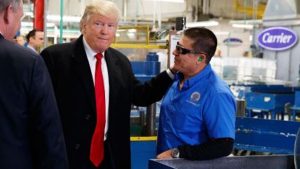 From 2011 to 2013, the city of Indianapolis and the state of Indiana gave Carrier and an affiliated company $1.7 million in grants and tax incentives, as an inducement to keep two manufacturing plants in the state and bring additional work in. It turned out not to be enough.
From 2011 to 2013, the city of Indianapolis and the state of Indiana gave Carrier and an affiliated company $1.7 million in grants and tax incentives, as an inducement to keep two manufacturing plants in the state and bring additional work in. It turned out not to be enough.
Earlier this year, Carrier said it would move those factories to Mexico, eliminating 2,000 jobs and saving $65 million. Indiana and its governor, Mike Pence, demanded most of the tax break money back, and got it.
Then Donald Trump got elected president. Trump had bashed Carrier while campaigning, saying that if he were president, companies wouldn’t get away with such a move. And now, Trump has persuaded Carrier to keep at least half of the 2,000 jobs it planned to outsource in Indiana, a remarkable instance of federal arm-twisting aimed at a single corporation. “Companies are not going to leave the U.S. anymore without consequences,” Trump said while touring the Carrier factory in Indiana.
To reach the deal, Indiana reportedly offered the heating and air conditioning company $7 million in new tax incentives, more than 4 times the previous inducement. So in that regard, Trump may have helped Carrier get a better deal. And there’s no federal commitment—the money will supposedly come from Indiana, courtesy of Hoosier taxpayers.
There’s also the possibility that Trump’s negotiators privately threatened to scale back on contracts awarded to Carrier’s parent company, United Technologies (UTX), a big defense contractor with more than $5 billion in annual revenue from federal contracts. Or, Trump may have promised UT a louder voice in upcoming negotiations over tax cuts and regulatory cutbacks than it might have otherwise had.
The deal is obviously good news for the Carrier workers who get to keep their jobs, but Trump’s intervention in a public company’s business decisions springs all kinds of red flags. For one thing, tax incentives are generally a lousy way to keep jobs, even though many states offer them. One study found that states spent an average of $456,000 per job to lure or keep employers within their boundaries, an amount that raises the question—why not just give the money to workers directly? Another study pointed out that tax breaks are rarely targeted at the young, growing companies that create most new jobs, and instead tend to go to big, established companies that don’t do much new hiring.
Perverse incentives
Tax breaks also create perverse incentives. Companies, for instance, have learned to play one state off another when angling for the best tax deal they can get for a new plant or facility. When the state of Connecticut wouldn’t lower General Electric’s taxes, it decided to move its headquarters to Boston, where it got a much better deal. Companies could do the same thing at the federal level by threatening to move jobs out of the country, to see what Trump might offer them to stay.
Tax incentives that offset the cost of labor also give companies a stronger incentive to substitute automation and other types of technology for labor, as long as they’re not committed to a minimum number of jobs. That way, employers can benefit from tax breaks while still lowering labor costs by replacing people with machines.
It’s also obvious that Trump can’t negotiate tax incentives one-by-one with every company that’s considering offshoring jobs. Republicans have said for decades that the government shouldn’t be in the business of picking winners and losers, and it should stay out of the way instead of trying to influence corporate decision-making. Trump obviously feels differently. A lot of CEOs should probably start to prepare for an unexpected phone call.
